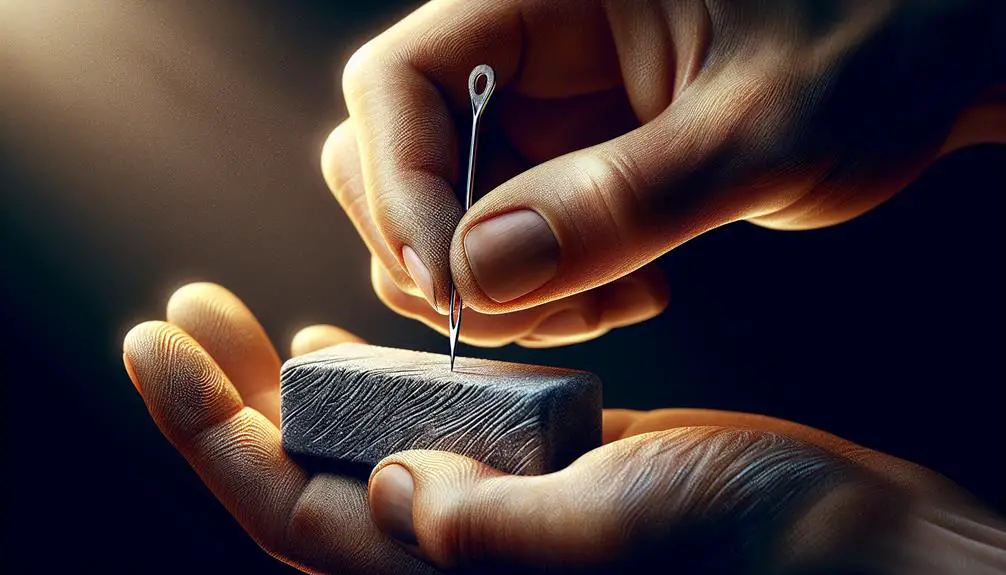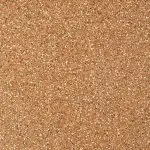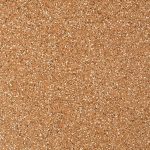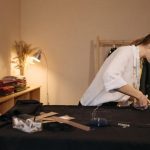Ever heard that saying about finding a needle in a haystack? Well, sharpening a needle is a whole different challenge.
The intricate process of honing a needle's point to precision requires finesse and the right approach. Wondering how to achieve that perfect sharpness?
Let's explore the art of needle sharpening, from selecting the ideal tools to mastering the techniques that ensure a needle remains a vital instrument in medical practices.
Stay tuned to uncover the secrets of needle sharpening that could make all the difference in your procedures.
Table of Contents
Key Takeaways
- Use a cork and adjust thrust angle for efficient needle sharpening.
- Measure forces for penetration to assess needle sharpness accurately.
- Regularly monitor and maintain needle sharpness for optimal patient care.
- Select appropriate sharpening tools based on durability and sharpening needs.
Needle Sharpening Methods
When sharpening needles, I find that utilizing a cork is a highly efficient method. By adjusting the thrust angle, you can vary the bevel length to achieve optimal sharpness, especially when sharpening hypodermic needles. Creating incisions on the cork enhances the sharpening process, ensuring a precise edge. To sharpen effectively, align the needle parallel to the cork surface, allowing for consistent and accurate sharpening results.
Using a cork for sharpening hypodermic needles provides a stable surface that promotes control over the sharpening process. This method is particularly useful for medical professionals who rely on sharp needles for procedures. By maintaining the sharpness of your needles regularly, you not only ensure the efficiency of your medical tools but also prioritize the well-being of your patients. Sharpening needles with a cork is a simple yet essential technique that can significantly impact the quality of care you provide.
Assessing Needle Sharpness
When it comes to assessing needle sharpness, it's crucial to understand the methods used to evaluate sharpness.
Recognizing the importance of keeping needles sharp is essential to ensure optimal performance in medical procedures.
Exploring ways to enhance their sharpness can help minimize risks associated with dull or damaged needles.
Sharpness Evaluation Methods
To assess the sharpness of a needle accurately, one must measure the forces required for penetration during testing. Evaluating needle sharpness is crucial in various fields, especially in medicine. Here are some methods commonly used for assessing needle sharpness:
- Peak Force Measurement: Determining the maximum force needed for penetration.
- Sharpness Retention Testing: Assessing how well a needle maintains its sharpness over time.
- Comparative Testing: Contrasting the sharpness of different needles to gauge their effectiveness.
- Needle Dulling Analysis: Studying the rate at which a needle loses its sharpness with repeated use.
These methods play a vital role in ensuring that needles perform optimally, particularly in medical settings where precision is paramount.
Importance of Sharpness
Coming from the discussion on sharpness evaluation methods, understanding the significance of needle sharpness is essential in ensuring optimal performance in various fields, particularly in medicine. Sharp needles are crucial for reducing patient discomfort and achieving efficient medical procedures. Regular assessment of needle sharpness can help healthcare professionals maintain safety and effectiveness during needle usage. To highlight the importance of sharp needles, consider the table below:
| Needle Gauge | Dulling Pattern | Optimal Sharpness |
|---|---|---|
| 20G | Sooner dulling | Requires frequent assessment |
| 22G | Moderate dulling | Regular checks recommended |
| 25G | Slow dulling | Maintain with sharpening stone |
In the medical field, the use of a sharpening stone can aid in preserving needle sharpness, ensuring precise and comfortable procedures.
Improving Needle Sharpness
Assessing needle sharpness is a critical practice in maintaining optimal performance and ensuring patient safety in medical procedures. To sharpen the needle effectively, consider the following:
- Monitor Usage: Keep track of the number of uses to assess when the needle may need sharpening.
- Perform Visual Inspection: Look for signs of bluntness such as bending or dull tips.
- Test Penetration: Check the force required for penetration to gauge sharpness.
- Seek Professional Help: Consult with experts or follow manufacturer guidelines for proper sharpening techniques.
Regularly evaluating needle sharpness is essential for efficient medical procedures and patient well-being.
Selecting Sharpening Tools
When it comes to selecting sharpening tools for needles, it's crucial to choose ones that are durable and specifically made for the task.
Look for sharpening stones designed to handle the delicate sharpening needs of needles.
Consider factors like material and grit to ensure optimal performance in keeping your needles sharp and ready for use.
Choosing Proper Tools
Considering the frequency of needle sharpening and the durability requirements, how do I select the most suitable sharpening tools for optimal results? When choosing tools to sharpen needles, it's crucial to prioritize quality and efficiency. Here are some key factors to keep in mind:
- Durable Sharpening Stone: Opt for a sharpening stone specifically designed for needles to ensure effectiveness.
- Sharpening Jig: Utilize a sharpening jig for precise sharpening and to save time.
- Material and Grit: Consider the material and grit of the stone for longevity and performance.
- Stone Hardness: Select harder stones like diamond for frequent sharpening needs to maintain needle sharpness effectively.
Essential Sharpening Supplies
To ensure optimal sharpening results for your needles, selecting the right sharpening tools is crucial for maintaining their sharpness and durability. Choose a durable sharpening stone specifically designed for sharpening needles. Utilize a sharpening jig for precise and time-saving benefits.
When selecting a stone, consider its material and grit for optimal performance. Opt for harder stones like diamond for frequent sharpening needs to keep needles sharp. Match the sharpening stone to the frequency of sharpening required and the durability needed for needle sharpening.
Choosing Sharpening Stones
Select the appropriate sharpening stone based on your frequency of use and durability requirements to ensure optimal sharpening results. When it comes to choosing sharpening stones for needle sharpening, consider the following tips:
- Diamond or Ceramic Stones: Opt for these for frequent sharpening needs as they offer durability and consistent results.
- Natural or Synthetic Oil Stones: Ideal for occasional touch-ups, providing a balance between performance and cost.
- Sandpaper on Glass: A cost-effective alternative for those looking for budget-friendly options or occasional use.
- Stone Material and Grit: Choose a stone material and grit that aligns with your sharpening requirements to maintain needle sharpness effectively.
Using Sharpening Jigs
When it comes to sharpening needles effectively, mastering the use of sharpening jigs is key.
These handy tools assist in maintaining consistent angles, ensuring precise sharpening outcomes.
Jig Types and Uses
Sharpening jigs are essential tools for maintaining precise angles and achieving consistent sharpness when honing needles. When it comes to needle sharpening jigs, here are some key points to consider:
- Versatility: Different types of sharpening jigs cater to various needle sizes and configurations, offering versatility in sharpening options.
- Consistency: They ensure uniform sharpness across multiple needles by maintaining consistent sharpening angles.
- Time-saving: Using a quality sharpening jig can save time and effort in maintaining sharp needles for medical procedures.
- Ease of Use: Precision and ease of use are key benefits of utilizing sharpening jigs, making the honing process more efficient and effective.
Sharpening Process Steps
To begin the process of sharpening needles using sharpening jigs, start by securely positioning the needle within the jig to ensure the desired angle for accurate sharpening. Utilize the sharpening jig to maintain consistent and precise sharpening strokes, adjusting it as needed to accommodate various needle sizes and configurations. By aligning the needle parallel to the sharpening surface within the jig, you can benefit from the simplicity and versatility of this tool. Below is a table summarizing the key steps in the sharpening process using a sharpening jig:
| Sharpening Process Steps using Sharpening Jigs |
|---|
| Secure the needle in the sharpening jig |
| Utilize the jig for consistent sharpening strokes |
| Adjust the jig for different needle sizes |
Needle Maintenance Tips
For those seeking to maintain needle sharpness effectively, utilizing a sharpening jig can significantly enhance the longevity and precision of needle maintenance. Sharpening jigs offer consistency in angles, ensuring optimal sharpness.
Here are some tips for using sharpening jigs:
- Quality jigs provide secure needle placement for precise sharpening.
- Customizable jigs accommodate various needle sizes and configurations.
- Investing in a reliable sharpening jig ensures efficiency in the sharpening process.
- Proper use of sharpening jigs can enhance the longevity and sharpness of medical needles.
Honing Needle Tips
When honing needle tips, securing the needle for sharpening is essential to ensure safety and precision throughout the process. For hypodermic needles, a clean and well-lit work surface provides stability during sharpening.
I recommend using a lubricated, high-quality sharpening stone to maintain sharpness. Consistency in maintaining the angle and pressure while honing is crucial for optimal results. It's important to avoid excessive honing, as this can damage the needle and compromise its effectiveness.
Maintaining Needle Sterility
Securing the sterility of needles is paramount to ensuring safe and effective medical procedures. To maintain needle sterilization, follow these essential practices:
- Sterilize Properly: Utilize autoclaving, ethylene oxide, or chemical disinfection methods to ensure thorough sterilization of needles.
- Store Safely: Keep needles in clean, dry, and sealed containers to prevent any potential contamination.
- Handle Carefully: Avoid touching the tips or surfaces of needles to preserve their sterility until use.
- Monitor Regularly: Inspect needles routinely for any signs of damage or contamination to guarantee safe and sterile conditions.
Needle Safety Practices
Wondering how to ensure the safety of needles during medical procedures? When it comes to needle safety practices, proper handling and maintenance are key. While needle sharpening is important for efficiency, it's crucial to avoid unnecessary sharpening to prevent damage.
Always store needles safely, out of reach of children and pets, to prevent accidents. Testing the sharpness of a needle before each use ensures it will be effective and reduce the risk of complications during procedures. Additionally, following safe disposal practices for used needles is essential to prevent infections and health risks.
Needle Maintenance Tips
Looking to keep your needles in top condition for sewing projects? Here are some needle maintenance tips to ensure they stay sharp and ready for use:
- Sharpen before storage: Before putting your needles away, take the time to sharpen them to guarantee they're in optimal condition when you next need them.
- Avoid excessive grinding: Be cautious not to over-sharpen your needles as this can lead to unnecessary scratches that may require additional polishing.
- Regular polishing: To maintain a smooth and sharp point, it's essential to regularly polish your needles to ensure efficient sewing.
- Test sharpness: Before starting a project, test the sharpness of your needle against your skin to ensure it's at its best for sewing tasks.
Following these needle maintenance tips, especially focusing on needle sharpening, will help you keep your needles in top shape and ready to tackle any sewing project with ease.
DIY Needle Sharpening Techniques
To keep your needles sharp and ready for your sewing projects, consider using DIY needle sharpening techniques like using an emery board or a fine-grit diamond/stone tool. When sharpening a needle, it's crucial to grind it to achieve a smooth metal surface, ensuring the needle's integrity.
To test the sharpness, lightly glide the needle against your skin before sewing to guarantee its effectiveness. After sharpening, polish the metal to a mirror-smooth finish using toothpaste or polishing paste for optimal results.
Remember to thoroughly clean off any residue post-sharpening to prevent contamination during your sewing projects. Additionally, a flat stone can also be used to sharpen needles effectively.
Professional Needle Sharpening Services
When seeking to maintain the sharpness of needles for sewing projects, turning to professional needle sharpening services can provide precision and efficiency in ensuring optimal needle performance. These services offer a range of benefits that make them a valuable option for those looking to keep their needles in top condition:
- Specialized Equipment: Professional needle sharpening services utilize advanced machinery designed specifically for sharpening needles, ensuring consistent results.
- Efficient for Large Quantities: Ideal for individuals or organizations with a high volume of needles to sharpen, these services can handle large quantities efficiently.
- Expert Technicians: Skilled technicians in needle sharpening services can expertly assess the condition of needles and apply the most suitable sharpening techniques.
- Quick Turnaround Times: Professional services often boast quick turnaround times, minimizing downtime for businesses or sewing enthusiasts in need of sharpened needles.
Needle Care and Storage Suggestions
Proper care and storage of needles is essential to maintain their sharpness and usability over time. To ensure safety, always keep needles out of reach of children and pets. Before storing, it's important to sharpen and polish the needles properly. However, be cautious as unnecessary grinding can lead to scratches, which may require additional polishing to maintain smoothness. By polishing needles before storage, you guarantee they're ready for immediate use without any rough surfaces. Remember, even a microscopically rough surface on a needle can mimic a blunt point, emphasizing the significance of proper maintenance.
When it comes to needle care and storage, precision is key. By following these simple suggestions, you can prolong the life of your needles, ensuring they remain sharp and efficient for all your sewing needs. Taking the time to care for your needles properly won't only save you time in the long run but also enhance your overall sewing experience.
Frequently Asked Questions
Can Needles Be Sharpened Multiple Times, or Is It Recommended to Replace Them After Sharpening Once?
It's generally best to replace needles after sharpening them once. Repeated sharpening can weaken the needle, affecting its performance and potentially causing it to break. Keeping fresh needles ensures optimal results and reduces the risk of accidents.
Are There Any Specific Types of Needles That Should Not Be Sharpened, or Is It Safe to Sharpen All Types of Needles?
Sharpening needles can vary based on type. Some needles, like medical ones, shouldn't be sharpened due to contamination risks. Always check needle guidelines. It's crucial to prioritize safety when considering sharpening different types of needles.
How Often Should Needles Be Sharpened to Ensure Optimal Performance?
I sharpen needles regularly for optimal performance. It's essential to maintain their sharpness to ensure precise work. Depending on use, I sharpen every 2-3 projects. A sharp needle is a must for seamless stitching.
Is There a Specific Technique to Test the Sharpness of a Needle After Sharpening?
To test the sharpness of a needle after sharpening, I recommend gently touching the tip to my fingernail. If it catches or snags, it's sharp. If it glides smoothly, additional sharpening may be needed.
Are There Any Common Mistakes to Avoid When Sharpening Needles at Home?
Common mistakes to avoid when sharpening needles at home include using excessive force, inconsistent angles, and skipping proper finishing steps. These errors can lead to uneven sharpness, weakened needles, and potential injury.
- How Does Ring Spun Cotton Affect Garment Fit and Shape Retention? - August 13, 2024
- What Are the Challenges in Producing Ring Spun Cotton? - August 13, 2024
- Is Ring Spun Cotton Suitable for Plus-Size Clothing? - August 13, 2024





